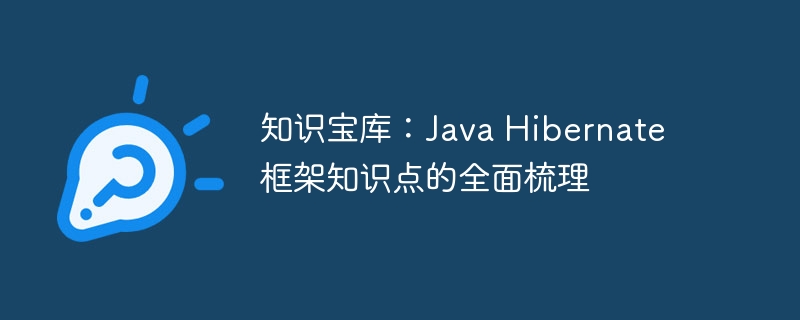Home >Java >javaTutorial >Knowledge treasure house: A comprehensive review of Java Hibernate framework knowledge points
Knowledge treasure house: A comprehensive review of Java Hibernate framework knowledge points
- 王林forward
- 2024-02-19 16:48:08915browse

php editor Xiaoxin takes you to explore the treasure trove of knowledge about the Java Hibernate framework. As one of the popular ORM frameworks in Java, Hibernate is favored by developers. This article will comprehensively sort out the important knowledge points of the Hibernate framework to help readers deeply understand and master the application skills of this powerful tool.
The entity class is one of the most important concepts in Hibernate. It represents a table in the database. The attributes in the entity class correspond to the columns in the table, and the methods in the entity class correspond to the operations in the table.
@Entity
public class User {
@Id
@GeneratedValue
private Long id;
private String name;
private String email;
//省略其他属性和方法
}
2. Data access object
Data Access Object (DAO) is another important concept in Hibernate, which is responsible for operating database. A DAO is usually an interface that defines methods for operating on the database.
public interface UserDao {
void save(User user);
User get(Long id);
List<User> getAll();
void update(User user);
void delete(User user);
}
3. Session Factory
The session factory is the object responsible for creating sessions in Hibernate. A session is a lightweight object used by Hibernate to interact with the database. It contains the connections and transactions required to operate the database.
SessionFactory sessionFactory = new Configuration()
.configure("hibernate.cfg.xml")
.buildSessionFactory();
4. Mapping file
The mapping file is a file used in Hibernate to define the mapping relationship between entity classes and database tables. Mapping files usually use XML format, which contains the mapping relationship between attributes in entity classes and columns in database tables.
<hibernate-mapping> <class name="User"> <id name="id"> <generator class="native"/> </id> <property name="name"/> <property name="email"/> //省略其他属性和映射关系 </class> </hibernate-mapping>
5. Cascade
Cascading is a feature in Hibernate that allows automatic cascading to child objects when operating on parent objects. Cascades can be divided into four types:
- Cascading save: When the parent object is saved, its child objects are automatically saved.
- Cascade update: When the parent object is updated, its child objects are automatically updated.
- Cascade deletion: When the parent object is deleted, its child objects are automatically deleted.
- Cascade refresh: When the parent object is refreshed, its child objects are automatically refreshed.
6. Lazy loading
Lazy loading is a feature in Hibernate that allows entity objects to be loaded only when needed. Lazy loading can improve the performance of your program because it reduces the number of database accesses.
@Entity
public class User {
@Id
@GeneratedValue
private Long id;
private String name;
@OneToMany(mappedBy = "user", fetch = FetchType.LAZY)
private List<Order> orders;
//省略其他属性和方法
}
7. Caching
Cache is a feature in Hibernate that allows loaded entity objects to be cached in memory for quick access later. Caching improves program performance because it reduces the number of database accesses.
@Entity
@Cache(usage = CacheConcurrencyStrategy.READ_WRITE)
public class User {
@Id
@GeneratedValue
private Long id;
private String name;
private String email;
//省略其他属性和方法
}
Summarize:
Hibernate is a powerful Java persistence framework, which can help us operate the database conveniently. The main concepts of Hibernate include entity classes, data access objects, session factories, mapping files, cascades, lazy loading and caching. These concepts are very important to understand and use the Hibernate framework.
The above is the detailed content of Knowledge treasure house: A comprehensive review of Java Hibernate framework knowledge points. For more information, please follow other related articles on the PHP Chinese website!

